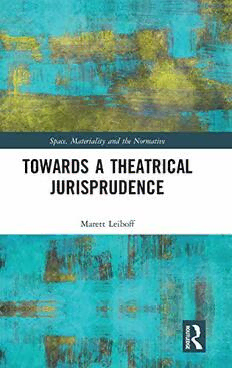
Towards a Theatrical Jurisprudence PDF
Preview Towards a Theatrical Jurisprudence
Towards a Theatrical Jurisprudence Thisbookbringstheinsightsoftheatretheorytolaw,legalinterpretationandthe jurisprudential to reshape law as a practice of response and responsibility. Confronting a Baconian antitheatrical legality embedded in its jurisprudences and interpretative practices, Marett Leiboff turns to theatre theory and practice to ground a theatrical jurisprudence, taking its cues from Han-Thies Lehmann’s conception of the post-dramatic theatre and the early work of theatre visionary Jerzy Grotowski. She asks law to move beyond an imagined ideal grounded in Aristotelian drama and tragedy, and turns to the formation of the legal inter- preter – lawyer, judge, jurisprudent – as fundamental to understanding what’s “noticed” or not noticed in law. We “notice” most easily through that which is written into the body of the legal interpreter, in a way that can’t be replicated through law’s standard practices of thinking and reasoning. Without more, think- ing and reasoning are the epitome of antitheatricality legality; a set of theatrical antonyms, including transgression and instinct, offer instead a set of possibilities through which to reconceive assumptions and foundational concepts etched into the legal imaginary. And by turning to critical dramaturgy, the book reveals that the liveliness that sits behind theatrical jurisprudence isn’t a new concept in law at all, but has a long pedigree and lineage that had been lost and hidden. Theatrical jurisprudence, which demands an awareness of self and beyond self, grounds a responsiveness that can’t be found within doctrine, principle, or the technocratic, but also challenges us to notice what it is we think we know as well as what we know of lives in law that aren’t our own. The book will be of interest to scholars and students in the field of jur- isprudence, legal theory, theatre and performance studies, cultural studies and philosophy. Marett Leiboff is Associate Professor of Law at the University of Wollongong, Australia. Space, Materiality and the Normative Series Editors: Andreas Philippopoulos-Mihalopoulos and Christian Borch Space, Materiality and the Normative presents new ways of thinking about the connections between space and materiality from a normative perspective. At the interface of law, social theory, politics, architecture, geography and urban studies, theseriesis concernedwithaddressingtheuse,regulationandexperienceofspace and materiality, broadly understood, and in particular with exploring their links and the challenges they raise for law, politics and normativity. Books in this series: Border Security Shores of Politics, Horizons of Justice Peter Chambers Towards a Theatrical Jurisprudence Marett Leiboff Forthcoming: Placing International Law Authority, Jurisdiction, Technique Fleur Johns, Shaun McVeigh, Sundhya Pahuja, Thomas Skouteris, and Robert Wai Controlling Urban Events Law, Ethics and the Material Andrea Pavoni Spatial Justice in the City Sophie Watson https://www.routledge.com/Space-Materiality-and-the-Normative/book-series/ SMNORM Towards a Theatrical Jurisprudence Marett Leiboff Firstpublished2020 byRoutledge 2ParkSquare,MiltonPark,Abingdon,OxonOX144RN andbyRoutledge 52VanderbiltAvenue,NewYork,NY10017 aGlassHousebook RoutledgeisanimprintoftheTaylor&FrancisGroup,aninformabusiness ©2020MarettLeiboff TherightofMarettLeibofftobeidentifiedasauthorofthisworkhasbeen assertedbyherinaccordancewithsections77and78oftheCopyright,Designs andPatentsAct1988. Allrightsreserved.Nopartofthisbookmaybereprintedorreproducedor utilisedinanyformorbyanyelectronic,mechanical,orothermeans,now knownorhereafterinvented,includingphotocopyingandrecording,orinany informationstorageorretrievalsystem,withoutpermissioninwritingfromthe publishers. Trademarknotice:Productorcorporatenamesmaybetrademarksorregistered trademarks,andareusedonlyforidentificationandexplanationwithoutintent toinfringe. BritishLibraryCataloguinginPublicationData AcataloguerecordforthisbookisavailablefromtheBritishLibrary LibraryofCongressCataloging-in-PublicationData Names:Leiboff,Marett,author. Title:Towardsatheatricaljurisprudence/MarettLeiboff. Description:Abingdon,Oxon;NewYork,NY:Routledge,2020.| Series:Space,materialityandthenormative Identifiers:LCCN2019015168(print)|LCCN2019018276(ebook)|ISBN 9781315562346(ebk)|ISBN9781138672789(hbk) Subjects:LCSH:Jurisprudence.|Sociologicaljurisprudence.| Law--Psychologicalaspects. Classification:LCCK240(ebook)|LCCK240.L452020(print)| DDC340/.11--dc23 LCrecordavailableathttps://lccn.loc.gov/2019015168 ISBN:978-1-138-67278-9(hbk) ISBN:978-1-315-56234-6(ebk) TypesetinGalliard byTaylor&FrancisBooks This book is dedicated to my mother, Elizabeth Leiboff (1929–2018), with love. http://picpoet.net Contents List of illustrations viii Preface ix Acknowledgments xii Before you turn the page … xv 1 The theatrical as jurisprudence 1 2 Law’s dramatic pretence 27 3 Law’s lost presence 55 4 The moral theatre 88 5 The encounter 107 6 Reclaiming the holy lawyer 120 7 Towards a theatrical jurisprudence 134 Bibliography 143 Index 158 Illustrations Figures 4.1 The Constant Prince, Wrocław 1965, Rena Mirecka and Ryszard Cieślak 94 4.2 TheConstant Prince, Wrocław1965,MajaKomorowskaandRyszard Cieślak 94 4.3 Akropolis Version III, Opole 1964, ZygmuntMolik, Ryszard Cieślak, Mieczysław Janowski, Andrzej Bielski, Gaston Kulig and Rena Mirecka 97 Table 3.1 From the Law’s Gens Project 83 Preface It is odd to contemplate what this book would have looked like if I had managed to complete it years ago, when I first began to conceive of a theatrical jur- isprudence. The book, as finally proposed in 2015, has changed. Most of the dif- ferences are largely inchoate, though some of the case examples I use have changed because of their potency as exemplars of the theatrical, and through the inevitable developments in the broader field since I first proposed the book, including the availability in English of Hans-Thies Lehmann’s extraordinary, magisterial volume Tragedy and Dramatic Theatre, published in 2016, which has now done so much of the work accounting for philosophy and theory’s antipathy towards theatre (and by extension jurisprudence and critical legal thinking) that has saved me reinventing this position and authorises my position from within theatre. Yet none of these instances explain why the book is different. Whatdrivesthedifference is a recognition,not noticedinhappier times, of just how much the theatrical, and by extension theatrical jurisprudence, is shaped by and responds to the challenges and dangers thrown out through and by time and place.Ithasalwaysbeenthus,butthepulltothejurisprudentialandlawsomehow obscured the theatrical’s activation in times of strife. The circumstances sur- roundingthecompletionofthisbookin2018areexemplaryinthisrespect,giving theatrical jurisprudence an urgency and piquancy unimaginable even two years before.This,then,iswhatmakesthebookdifferent,takingfurtheritsoriginaltask of asking us as lawyers to notice and be aware beyond our own selves, to under- stand just how much of ourselves is deployed in undertaking the most minute practices of law, and to be aware of the material conditions of existence as an essential and fundamental facet of our engagement with law and its texts. What this reminds us, too, is that law is inevitably bound up in each of our lives and in the time and place from which we experience and imagine it, and it reminds us too that there is something extra that we need as lawyers to hear the signals and warnings of law that might, and could, go wrong. In a sense, this book needed to wait until the time was right, though it wasn’t clear, ever, that this time would come. That its time did come is not a cause for celebration, though, but regardless, the book would have been finished, but it would have lacked the thing that it needed to make it do its work. So spending a few years on ice, in large part through circumstances that forced an unwanted
